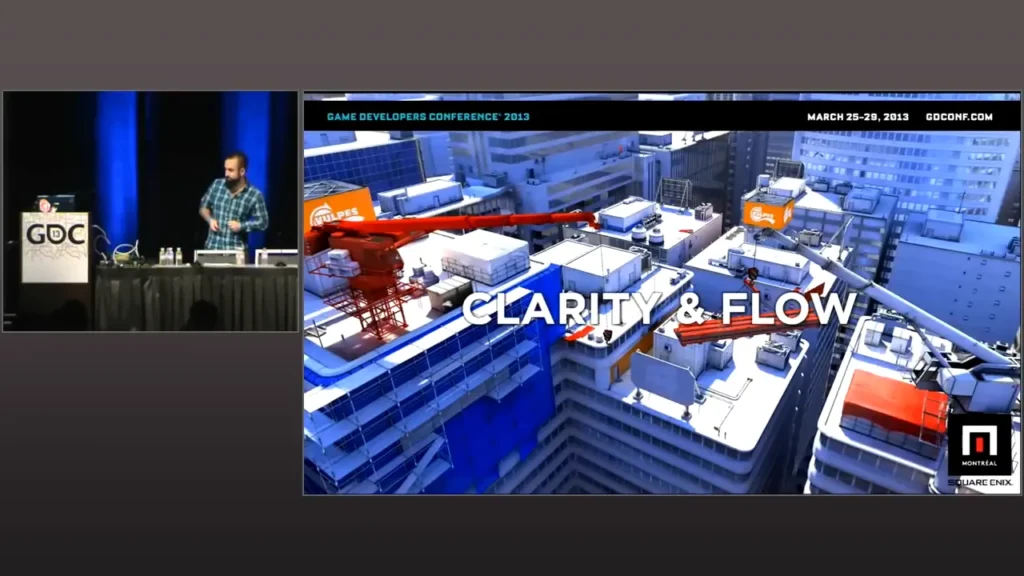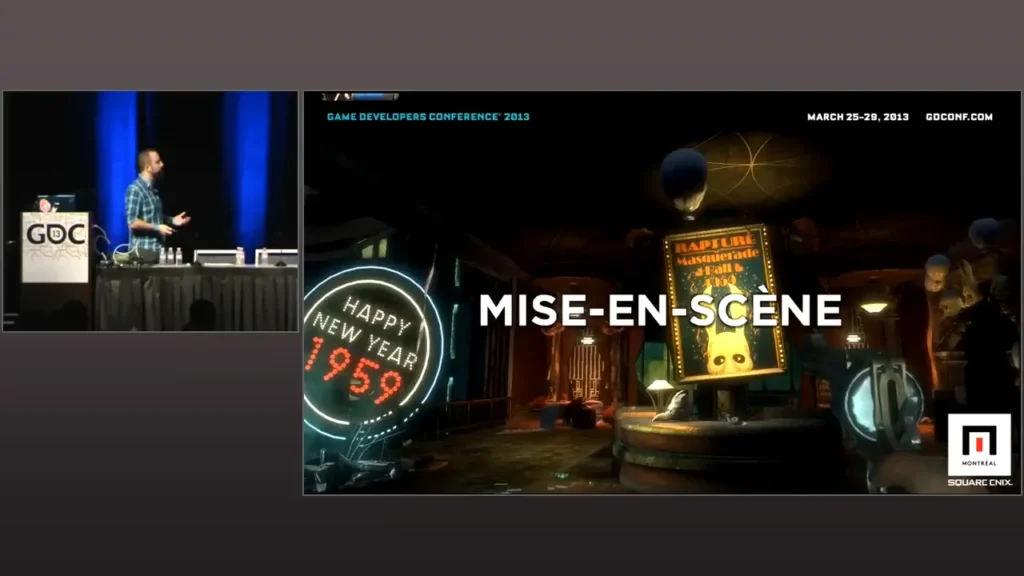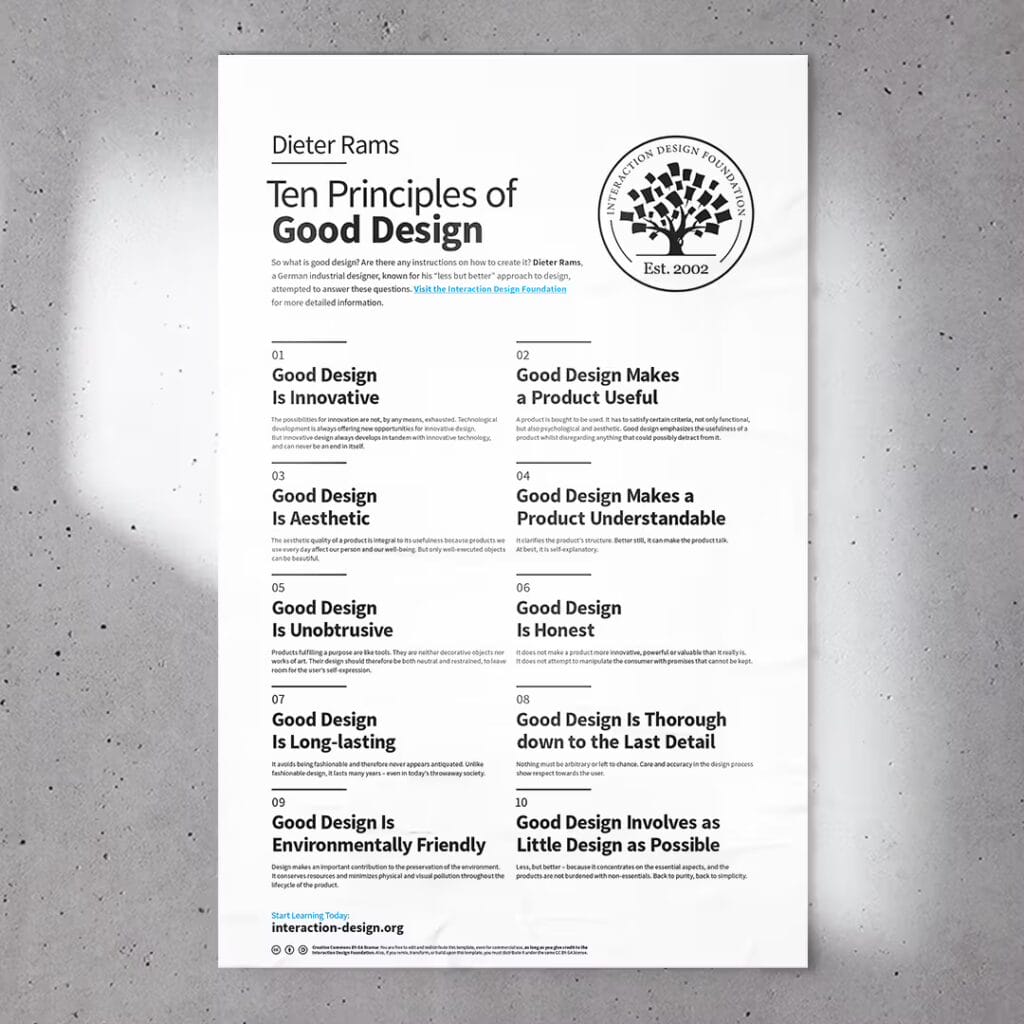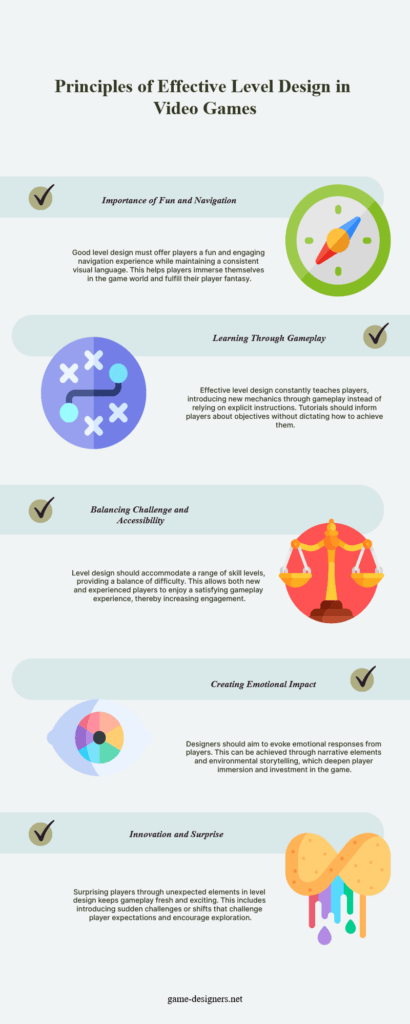We’ve got an exciting new video release just for you. This time, we’re diving deep into the world of level design and exploring the Ten Principles for Good Level Design.
If you’re an aspiring game designer or simply interested in understanding how captivating levels are created, this video and our summary that we’ve crafted is a must-see!
In this video game designer, Dan Taylor, shares his favorite level design experience from Medal of Honor Heroes 2. He explains the key factors that set this level apart, such as its ability to effectively teach motion controls on the Wii and capture the essence of the original Medal of Honor game.
Ten Principles for Good Level Design Key Takeaways
Here are 5 key takeaways from the video:
- The importance of a well-designed tutorial level that successfully introduces core mechanics.
- Balancing the effort put into level design with the chance of players figuring out the mechanics themselves.
- The challenge of disrupting player expectations and avoiding predictability.
- Accommodating a broader audience through accessible level design, without breaking immersion.
- The crucial role of self-criticism and understanding the player’s experience in level design.
Level design is one of the most crucial aspects of game development, shaping how players experience a game’s world, challenges, and narrative. Drawing from decades of experience in the industry, including work on iconic franchises and studios like Square Enix Montreal, Sony, Rockstar, and Ubisoft, this guide distills the art and science of level design into ten foundational principles. These principles are inspired by classic design philosophies and tailored specifically to the interactive and immersive nature of video games.
Whether you’re an aspiring level designer or a seasoned developer, understanding these 10 Principles of Level Design will help you create levels that are not only functional but also memorable, emotionally resonant, and endlessly engaging.
1. Good Level Design is Fun to Navigate
Navigation is the player’s primary interaction with your level. It involves three core gameplay vectors:
- Observational: Surveying the surroundings.
- Strategic: Formulating a plan based on what’s observed.
- Navigational: Physically moving through the level.
For a smooth and enjoyable experience, players should always have a clear understanding of where to go. This clarity comes from developing a consistent visual language that guides players along the critical path using elements such as light, geometry, color, and animation.
A stellar example is Mirror’s Edge, where the use of bright red objects like cranes and pipes naturally draws the player’s eye and directs their movement. The game subtly balances intuitive navigation with opportunities for exploration through hidden paths and collectibles, encouraging freestyle navigation that adds depth and replayability.

Sometimes, however, a little confusion can enhance the experience. The favela level in Modern Warfare 2 is a tight, twisty maze with enemies attacking from all directions. While it’s challenging to navigate, the chaos adds to the dramatic tension, making the level highly memorable and fun.
2. Good Level Design Does Not Rely on Words to Tell the Story
Storytelling in levels should be a broken circle, where the player fills in the gaps. If the gap is too large, players feel lost and patronized. Too small, and they become bored. The key is balancing explicit, implicit, and emergent narratives.
- Explicit Narrative: Cutscenes, text, or dialogue directly telling the story.
- Implicit Narrative: Environmental storytelling where players infer what happened by observing surroundings.
- Emergent Narrative: Stories players create themselves through their choices and actions.
Bioshock is a masterclass in implicit narrative. Environmental clues like water flooding, abandoned party decorations, and eerie masks tell a story of a city gone wrong without a single word. The visual disparity between 1950s decor and the 1960s date adds unease and depth.

Emergent narrative thrives in games like Hitman, where players choose how to eliminate targets using a variety of mechanics. Whether poisoning food, using fiber wire, or pushing enemies off ledges, the freedom to improvise creates unique stories in every playthrough.
3. Good Level Design Always Tells the Player What to Do but Never How to Do It
Clear objectives are essential, but the method of achieving them should be open-ended. Players need to know their goals without being forced into a single solution.
Skyrim exemplifies this with its Dark Brotherhood missions: the player knows who to find and where, but can choose from multiple assassination methods. This approach encourages creativity and prevents frustration.
Moreover, players should never be punished for improvisation. Unexpected player actions must be embraced and integrated into the game design, which ties back to emergent narrative principles.

4. Good Level Design Constantly Teaches the Player Something New
Fun in games often comes from recognizing and mastering patterns. According to Ralph Koster’s The Theory of Fun, the human mind enjoys processing patterns, and gameplay should keep introducing or subverting mechanics to prolong engagement.
The Zelda series is a prime example. New dungeons introduce equipment, and each room teaches a new way to use it. The final boss tests mastery, ensuring players gradually build skills.
Bethesda follows a loop of learn, play, challenge, surprise to pace gameplay. They teach mechanics explicitly, provide safe spaces to experiment, introduce challenges, and then surprise players to keep things fresh.
5. Good Level Design is Surprising
Predictability kills excitement. While pacing is important, designers must disrupt routines and expectations to keep players on their toes. Fun arises from uncertainty and the unexpected.
The “Ishimura” level in Dead Space 2 subverts expectations by delaying enemy encounters, building tension before unleashing a massive monster. This pacing break is a risk that paid off, demonstrating how constraints can foster creativity.

Risk-taking is essential but must be managed carefully through early testing and iteration. Unproven ideas risk being cut late in development, as happened with grenade puzzles in Medal of Honor, which could have enhanced player empowerment.
6. Good Level Design Empowers the Player
Games are escapism, and players want to feel powerful and impactful. Levels should avoid mundane tasks that players could do in real life, instead delivering exciting, larger-than-life experiences.
Red Faction Guerrilla exemplifies this by letting players destroy environments with powerful weapons, reinforcing the fantasy of being a Martian rebel. Destructible terrain amplifies player influence on the world.
Infamous uses a karma system that reflects player choices in subtle ways—citizens cheer or boo depending on your morality, and your actions affect gameplay, reinforcing player agency.
Rescuing hostages in Medal of Honor alters later levels by providing allies, rewarding daring play styles and making the player feel their choices matter.
7. Good Level Design is Easy, Medium, and Hard
Difficulty should be dynamic and player-driven rather than imposed by an arbitrary select screen. Offering multiple pathways with clear risk-reward balances lets players tailor their own challenge.
Burnout is a king of this approach, with narrow, risky shortcuts clearly marked and offering significant rewards like reduced lap times. Players choose their difficulty by picking paths.
This principle extends beyond racing games. RPGs and shooters can place powerful weapons in hard-to-reach spots or provide stealth routes to bypass enemies, catering to diverse player skills and preferences.
Dishonored fills levels with multiple paths, puzzles, and styles of approach, enhancing replayability and catering to different player aptitudes.
8. Good Level Design is Efficient
Resources are finite—technical limitations, production schedules, and team sizes all constrain level design. Efficient design maximizes these resources through modularity, bidirectionality, and nonlinearity.
Modular design involves creating mechanic-driven encounters that can be reused and combined in multiple levels, creating familiarity and aiding player mastery. Bethesda’s toolkits are a great example of modular “LEGO” design enabling massive content creation by small teams.
Bidirectional gameplay means the journey through a level differs going forward and back, avoiding dull backtracking. Halo uses this well, with exploratory gameplay on the way in and intense combat on the way out.

Nonlinear levels with implicit objectives encourage exploration and replay without adding production costs. Collectibles like skulls in Halo or feathers in Assassin’s Creed extend gameplay naturally.
However, nonlinearity must be relevant and rewarding. Players should clearly understand the benefits of exploration, and objectives should tie into the main narrative to maintain engagement.
9. Good Level Design Creates Emotion
Video games are art forms designed to provoke emotional responses. Level design, akin to architecture, manipulates spaces to evoke feelings like power, fear, calm, or awe.
Architectural techniques such as window placement, room curvature, and spatial scale influence player emotions. Tight corners induce claustrophobia; vast open spaces inspire isolation or wonder; verticality can evoke vertigo or hope.
New Tomb Raider leverages these techniques by transitioning from narrow caves to open jungles, using spatial design to shape the player’s emotional journey.

Designers should start with the desired emotional response and work backward, selecting spatial, narrative, and mechanical elements that evoke that feeling. For example:
- Feeling persecuted: AI enemy constantly hunts the player.
- Exhilaration: High-speed chases or firefights in open areas.
- Urgency: Time limits modifying core mechanics.
- Desperation: Near-impossible goals with last-minute salvation.
Company of Heroes uses mission mechanics that lie to the player about reinforcements to heighten tension and desperation, showcasing how mechanics and level design combine to create emotion.
10. Good Level Design is Driven by the Game’s Mechanics
Above all, levels are the medium through which gameplay mechanics are delivered. They do not merely provide a backdrop but shape the reality in which mechanics exist and interact.
Think of your game as a painting:
- Subject: Gameplay mechanics
- Composition: Narrative and graphics
- Medium: The level design itself
Levels should be designed to showcase and reinforce mechanics. This requires close collaboration between designers, engineers, and artists, especially as mechanics and levels develop simultaneously.
Deus Ex: Human Revolution is a masterclass in mechanic-driven level design, with multiple paths highlighting stealth and combat mechanics, moments for using augmentations, and missions creatively leveraging game systems like body dragging and ragdoll physics.
However, it’s important to keep mechanics fresh by modifying their application creatively, as seen in the Riddler challenges in Batman Arkham City, which extend gameplay and deepen the player’s fantasy experience.
Recap: The 10 Principles of Level Design
- Fun to Navigate: Clear visual language with room for exploration and occasional chaos.
- Storytelling Without Words: Use implicit and emergent narratives over explicit exposition.
- Tell What to Do, Not How: Provide clear objectives with freedom in execution.
- Constantly Teach: Introduce, showcase, or subvert mechanics to maintain engagement.
- Be Surprising: Avoid predictability by disrupting pacing and expectations.
- Empower the Player: Deliver escapism that shows player impact on the world.
- Dynamic Difficulty: Use risk-reward paths so players choose their challenge.
- Efficiency: Design modular, bidirectional, and nonlinear levels.
- Create Emotion: Begin with desired emotional response and design accordingly.
- Mechanic-Driven: Showcase and reinforce gameplay mechanics through level design.
Each principle supports the others, creating a holistic approach that elevates level design from technical task to creative art.
Applying These Principles in Your Career
Level design is interdisciplinary. It blends mission structure, narrative, mechanics, and art. To excel, cultivate a broad skill set and collaborate effectively across disciplines. For those interested in pursuing this path, consider exploring resources like how to become a level designer and the importance of level design in video games.
Additionally, refining your understanding through practical experience and theory, such as the book review on practical level design, can deepen your grasp of these principles.
Addressing Challenges and Future Trends
Modern games face unique challenges. As audiences diversify, balancing accessibility with depth becomes paramount. Visual cues and navigational aids help newcomers without alienating veterans. Dynamic difficulty and player-driven challenge selection ensure games remain engaging for all skill levels.
Moreover, emotional storytelling is evolving. Games like Journey emphasize emotional resonance over empowerment, suggesting future level design may increasingly focus on emotional intelligence and player connection.
Multiplayer level design poses additional complexities, requiring further thought to adapt these principles effectively. Continuous playtesting and iterative design remain vital to balancing creative vision with player feedback.
Final Thoughts
Great level design blends clarity, creativity, emotion, and mechanical depth. It invites players into immersive worlds where they feel guided but free, challenged yet empowered, and emotionally connected to the experience.
By embracing the 10 Principles of Level Design, designers can craft levels that resonate long after the game is turned off, elevating player experiences and defining memorable games.
Dieter Rams’ 10 principles of good design
The 10 principles discussed in this article and in the video were inspired by Dieter Rams focused on Industria Design.
In the late 1970s, Dieter Rams was becoming increasingly interested in the world of things that surrounded him – “an impenetrable confusion of forms, colours and noises.” Rams, being a designer, recognized the significant impact he had on shaping the world. This realization led him to ponder a crucial question: does my design embody true excellence?
Good design is subjective and can’t necessarily be measured. However, Rams attempted to express what he believed to be the most important principles for design.
He already had left an indelible mark on the field of design with his timeless principles of good design. His ten principles serve as a compass for designers, guiding them towards creating products that are functional, aesthetically pleasing, and sustainable. While these principles were initially intended for industrial design, they can also be applied and adapted to other creative disciplines, such as game design.

Let’s explore how Dieter Rams’ principles can be linked to game design:
1. Good design is innovative: In game design, innovation is key to captivating players and providing unique interactive experiences. Creating novel mechanics, inventive storytelling, and original gameplay elements can set a game apart.
2. Good design makes a product useful: Games should offer enjoyable and engaging experiences to players. They should fulfill a purpose, whether it’s providing entertainment, education, or emotional catharsis. Ease of use and intuitive controls also contribute to the usefulness of a game.
3. Good design is aesthetic: Just like any other form of design, games should strive for visual appeal. Attention to detail, art direction, and graphic design enhance the overall player experience, immersing them in captivating virtual worlds.
4. Good design makes a product understandable: clear and intuitive communication is crucial in game design. Players should easily grasp the game mechanics, objectives, and rules without feeling overwhelmed. A well-designed user interface and effective tutorials can aid in making the game understandable.
5. Good design is unobtrusive: A game should not distract or hinder players from enjoying the experience. User interfaces should be minimalistic and non-intrusive, allowing players to fully immerse themselves in the game world.
6. Good design is honest: Game designers should strive for transparency and fairness. Players should feel that the game offers a level playing field, without hidden tricks or manipulative tactics. This fosters trust and creates a positive player experience.
7. Good design is long-lasting: In game design, longevity is often desired. To develop games that can withstand the test of time, it is essential to meticulously contemplate gameplay mechanics, ensure replayability, and regularly provide content updates. These strategies are crucial for keeping players engaged even long after the game’s initial release.
8. Good design is thorough down to the last detail: Attention to detail can make a remarkable difference in game design. From small animations and sound effects to well-crafted dialogue and immersive environments, every aspect should be polished to create a cohesive and immersive experience.
9. Good design is environmentally friendly: While this principle is more challenging to directly apply to game design, it can be interpreted as fostering sustainability within the industry. Encouraging eco-friendly practices, such as energy-efficient game development processes and reducing the environmental impact of hardware, can contribute to a more sustainable gaming ecosystem.
10. Good design is as little design as possible: Simplification and elegance play an essential role in game design. Stripping away unnecessary complexities and focusing on the core gameplay elements can create an experience that is both intuitive and enjoyable for players.
By aligning game design with Dieter Rams’ principles, creators can enhance the overall quality, user experience, and longevity of their games. Embracing these guidelines fosters innovation, aesthetic values, and user-centric design, ultimately creating memorable and engaging gaming experiences.
These principles have become iconic and have inspired designers across the world.
Other Resources:
10 Principles of Level design youtube video
Slideset Principles of Level design
Conclusion: 10 principles of good level design
In conclusion, level design plays a crucial role in shaping the player’s experience within a game. It encompasses elements such as navigation, visual language, storytelling, player empowerment, and balance. Effective level design goes beyond mere instruction, offering players a journey of discovery and growth.
By creating a consistent and engaging world, level designers have the power to immerse players in a captivating experience. Through the use of implicit narratives, they can tell stories without relying solely on words. Well-designed levels not only teach players how to play the game but also provide opportunities for continuous learning and challenge.
Surprise and unpredictability are key elements that make level design memorable, breathing life into the game world. By disrupting player expectations, designers can keep the gameplay fresh and exciting.
In addition, it is crucial for level design to be highly effective and cater to the diverse needs of players, striking a perfect equilibrium between presenting captivating challenges and granting players the freedom to leisurely explore the vast game universe.It’s a fine line to walk, but one that can lead to a rewarding experience for a wide range of players.
Ultimately, exceptional level design has the ability to evoke powerful emotions within players. By focusing on the desired player fantasy and emotional empowerment, designers can create truly impactful and unforgettable experiences.
Level design is much more than just constructing platforms and obstacles; it is a captivating art that demands a profound comprehension of player psychology, mechanics, and storytelling. The potential to craft immersive worlds and elicit emotional responses from players makes level design an essential component of any successful video game.

Frequently Asked Questions (FAQ) Principles of Good Level Design
What is level design in the context of game development?
A: Level design refers to the process of creating game levels, which involves designing the layout, challenges, rewards, and overall gameplay experience within a specific section of a game.
How does level design contribute to player engagement?
A: Level design plays a crucial role in engaging players by providing them with challenges, rewards, a sense of progression, and a feeling of accomplishment as they navigate through the game’s levels.
What are some key principles for creating engaging level design?
A: Some key principles for creating engaging level design include balance between challenge and reward, incorporating gameplay elements that guide players, and ensuring replayability through variety and skill level adaptation.
Why is level design important in the overall game design process?
A: Level design is important in the overall game design process as it enhances the player’s sense of immersion, provides visual cues for gameplay, and contributes to the overall gaming experience by creating a sense of world-building.
How can level design help game developers in creating successful games?
A: Effective level design can help game developers by improving player engagement, increasing replayability, and ensuring that the overall game experience is enjoyable and rewarding for players of varying skill levels.
What are some recommended practices for level designers to follow when creating game levels?
A: Recommended practices for level designers include playtesting their levels extensively, incorporating a balance of challenge and reward, creating a variety of level layouts, and ensuring that the levels enhance the game’s narrative and gameplay mechanics.
How can game developers ensure that their level design provides a sense of challenge and reward for players?
A: Game developers can ensure that their level design offers a sense of challenge and reward by carefully balancing the difficulty of the obstacles, providing meaningful rewards for overcoming challenges, and designing levels that offer a sense of accomplishment upon completion.
That’s all for now, fellow Game Designers. Stay tuned for more exciting content coming your way. Until then, keep leveling up your skills and creating awesome game experiences!



















